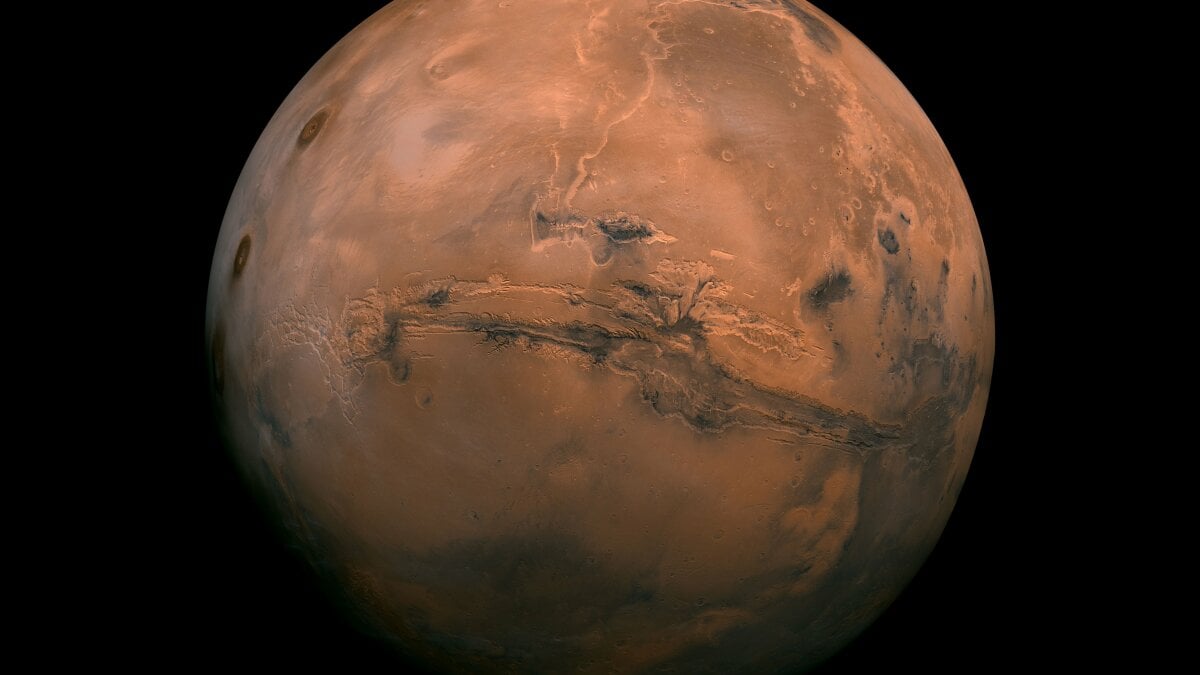Entertainment
Yes, Mars is spinning faster. Here’s what NASA found.

The Red Planet’s spin is speeding up a hair fast enough to shorten the length of a Martian day by a fraction of a millisecond per year.
NASA‘s Mars Insight lander died a few months ago, no longer able to generate power from its dust-covered solar panels, but scientists continue to learn new things about Earth’s neighboring planet from the data it collected. One of the latest revelations from the lander is on Mars’ unique jitterbug: how fast the planet rotates and wobbles.
Researchers measured Mars’ rotation over 100 million miles away in space using one of Insight’s instruments called the Rotation and Interior Structure Experiment — RISE for short — that includes a radio transponder and antennas. Understanding the internal workings of Mars gives scientists new clues about how the planet formed and changed over time and how those conditions played into the planet’s habitability.
“It’s really cool to be able to get this latest measurement — and so precisely,” said Bruce Banerdt, Insight’s principal investigator who retired from NASA on Aug. 1, in a statement. “I’ve been involved in efforts to get a geophysical station like Insight onto Mars for a long time, and results like this make all those decades of work worth it.”
For four years, Insight studied upward of 1,000 marsquakes from the surface of the Red Planet and collected daily weather reports. It has helped scientists map Mars’ inner geology and piece together its history.
The new findings contribute to the mounting evidence supporting the existence of a gooey, molten iron core at the center of Mars, making it similar to Earth and Venus, rather than a cooled, completely solid iron core. Earth has an outer liquid-iron core and solid inner core. The new research appears in Nature.
“It’s really cool to be able to get this latest measurement — and so precisely.”

For four years, Insight studied upward of 1,000 marsquakes from the surface of the Red Planet and collected daily weather reports.
Credit: NASA / JPL-Caltech
It follows another paper published in the Proceedings of the National Academy of Sciences in April, which used Insight seismic data to find more support for a liquidy core with high percentages of sulfur and oxygen. This makeup is much less dense than Earth’s core, according to the research, pointing to different formation conditions in the two planets.
“You can think of it this way; the properties of a planet’s core can serve as a summary about how the planet formed and how it evolved dynamically over time. The end result of the formation and evolution processes can be either the generation or absence of life-sustaining conditions,” said Nicholas Schmerr, a University of Maryland geologist, in a statement about the preceding paper. “The uniqueness of Earth’s core allows it to generate a magnetic field that protects us from solar winds, allowing us to keep water. Mars’ core does not generate this protective shield, and so the planet’s surface conditions are hostile to life.”
Want more science and tech news delivered straight to your inbox? Sign up for Mashable’s Light Speed newsletter today.
To track Mars’ spin rate, scientists harnessed the Deep Space Network — NASA’s radio dish system on Earth used to communicate with its farthest spacecraft — to send signals to Insight on Mars. Its RISE instrument would then bounce the signal back. When the signal returned, scientists would look for tiny changes in its frequency to determine how fast the planet is rotating. With data from Insight’s first 900 Martian days, they were able to observe these tiny, subtle variations.
The team isn’t sure why the planet is speeding up, but they have some ideas. The subtle acceleration could be from ice accumulating on the planet’s polar caps or “post-glacial rebound,” which causes land masses to rise after ice has buried them.
“The shift in a planet’s mass can cause it to accelerate a bit like an ice skater spinning with their arms stretched out, then pulling their arms in,” according to NASA.

Researchers measured Mars’ rotation from over 100 million miles away in space using one of Insight’s instruments called the Rotation and Interior Structure Experiment — RISE for short.
Credit: NASA / JPL-Caltech illustration
“The shift in a planet’s mass can cause it to accelerate a bit like an ice skater spinning with their arms stretched out, then pulling their arms in.”
Researchers also used the RISE data to measure Mars’ wobble, caused by sloshing of liquid in the heart of the planet. The measurement gives scientists an idea of the size of the core, which has a radius of 1,140 miles, about half the size of the planet.
Studying Mars’ wobble also gave the researchers an indication that masses buried deep within the planet’s mantle are deforming the core’s shape. Further Insight-supported research may yield more information about those anomalies in the future.
-

 Business7 days ago
Business7 days agoHumanoid robots are learning to fall well
-

 Entertainment6 days ago
Entertainment6 days ago2024 summer TV preview: 33 TV shows to watch this summer
-

 Business6 days ago
Business6 days agoGoogle Gemini: Everything you need to know about the new generative AI platform
-

 Business4 days ago
Business4 days agoHaun Ventures is riding the bitcoin high
-

 Entertainment5 days ago
Entertainment5 days ago‘Bridgerton’: Everything you need to remember before Season 3
-

 Entertainment4 days ago
Entertainment4 days agoHands-on with the Claude AI app: It’s pleasant to use, but janky
-

 Entertainment3 days ago
Entertainment3 days ago5 essential gadgets for turning your home into a self-care sanctuary
-

 Business6 days ago
Business6 days agoIndian ride-hailing giant Ola cuts 180 jobs in profitability push




























